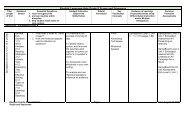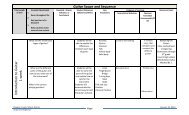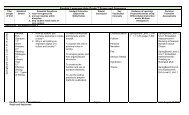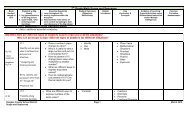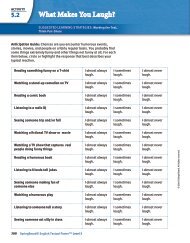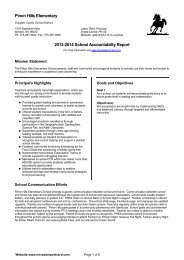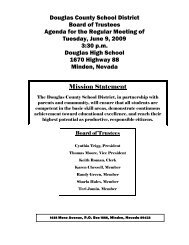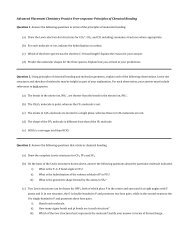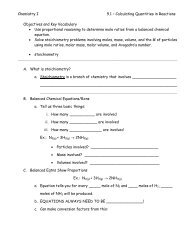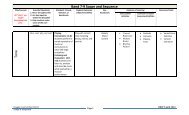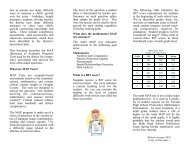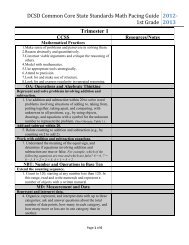Development of living organisms and basic classifications
Development of living organisms and basic classifications
Development of living organisms and basic classifications
You also want an ePaper? Increase the reach of your titles
YUMPU automatically turns print PDFs into web optimized ePapers that Google loves.
SCIENCE COMPETENCY CURRICULUM GUIDE<br />
Exit Competency B: Students will demonstrate competency in underst<strong>and</strong>ing <strong>basic</strong> principles <strong>and</strong> theories <strong>of</strong> life science whether<br />
from biology, zoology, anthropology, botany, genetics, including: 3: <strong>Development</strong> <strong>of</strong> <strong>living</strong> <strong>organisms</strong> <strong>and</strong> <strong>basic</strong> <strong>classifications</strong>.<br />
Objectives: Assessment: Possible Resources: Possible Strategies:<br />
By 9 th grade, students will:<br />
1. Trace the development <strong>of</strong> an<br />
organism from fertilization<br />
through the production <strong>of</strong><br />
<strong>of</strong>fspring using <strong>basic</strong> genetic<br />
concepts, by diagraming cellular<br />
reproduction, including:<br />
-chromosomes<br />
-cell development<br />
(See Competency A)<br />
Time:<br />
12 to 14 hours (3 weeks)<br />
B-3 Assessment Examples<br />
EXAMPLES OF THE TYPES OF<br />
ASSESSMENT ACTIVITIES<br />
THAT CAN BE USED TO<br />
ASSESS THE LEARNING<br />
OBJECTIVES<br />
1. Steve is five years old. His<br />
brother Bob is ten. Steve can wear<br />
clothes that used to fit Bob. Why<br />
do Bob’s clothes now fit Steve<br />
A. Bob’s clothes shrank.<br />
B. Old clothes fit well.<br />
UC. Steve is as big now as Bob<br />
once was.<br />
D. Bob now wears different<br />
clothes.<br />
E. Someone changed the size <strong>of</strong><br />
Bob’s clothes.<br />
Provided Instructional Resources:<br />
Life Science (7):<br />
S Holt Science & Technology;<br />
2001.<br />
Adopted. 7 th Grade <strong>and</strong> High<br />
School Remedial<br />
Glencoe Science: Physical Science,<br />
Glencoe/McGraw-Hill, 2005. 9 th<br />
-12 th Adopted<br />
Foundations <strong>of</strong> Science:<br />
S Foundations <strong>of</strong> Science, Prentice<br />
Hall, 2000 Cells <strong>and</strong> Heredity )<br />
S Resource Pro CD ROM<br />
S Integrated Science Laboratory<br />
Manual<br />
S West Student-Centered Activity<br />
Book<br />
S Assessment Resources CD<br />
ROM<br />
S Program Planning Guide<br />
S Integrated Science Activity<br />
Books I <strong>and</strong> II<br />
S Swift scopes<br />
S CBL Systems (including CBL,<br />
AC Adapter, DIN Adapter,<br />
TI-82, Temperature probe,<br />
Voltage probe <strong>and</strong> Light<br />
sensor)<br />
S Electronic Balances<br />
S Hot Plates<br />
S St<strong>and</strong> Supports<br />
S Life Science Interactive Student<br />
Tutorial CD-ROM<br />
S Life Science Videodiscs<br />
B3 Instructional Strategies could<br />
include:<br />
1. Activities - h<strong>and</strong>s-on<br />
S Lab<br />
S Flipbook on Mitosis<br />
S Discussion/survey (on cloning)<br />
S Notes from board<br />
S TA Model <strong>of</strong> Meiosis<br />
S The Yeast Life Cycle<br />
S Cellular <strong>Development</strong><br />
S DNA Replication<br />
S Chromosome replication<br />
June 17, 2006<br />
1
SCIENCE COMPETENCY CURRICULUM GUIDE<br />
Exit Competency B: Students will demonstrate competency in underst<strong>and</strong>ing <strong>basic</strong> principles <strong>and</strong> theories <strong>of</strong> life science whether<br />
from biology, zoology, anthropology, botany, genetics, including: 3: <strong>Development</strong> <strong>of</strong> <strong>living</strong> <strong>organisms</strong> <strong>and</strong> <strong>basic</strong> <strong>classifications</strong>.<br />
Objectives: Assessment: Possible Resources: Possible Strategies:<br />
B-3 Assessment Examples (cont’d)<br />
Biology:<br />
S Modern Biology, Holt, Rinehart<br />
<strong>and</strong> Winston, 1999<br />
S Teaching Resources<br />
S BioSources lab program<br />
S WARD’s materials ordering<br />
s<strong>of</strong>tware<br />
S BioSources technology<br />
resources<br />
S BioSources teaching<br />
transparencies<br />
S Holt Biology Videodiscs or<br />
Science in Action Videotapes<br />
S Microscopes<br />
2. Recognize that different<br />
characteristics <strong>of</strong> <strong>living</strong><br />
<strong>organisms</strong> are controlled through<br />
genes determined by the<br />
molecule DNA by applying <strong>basic</strong><br />
genetic ratios to problems <strong>of</strong><br />
heredity with punnet squares.<br />
B-3 Assessment Examples (cont’d)<br />
1. Supplementary Resources:<br />
S BSCS Biology: An Ecological<br />
Approach (2002)<br />
S “Immortal Thread” - Secret <strong>of</strong><br />
Life video series - PBS 1993<br />
text<br />
S “Geometry <strong>of</strong> Life” - The<br />
Infinite Voyage - Vestron 1988-<br />
video<br />
S “Twins” - 1996 - The Learning<br />
Channel - video<br />
S BSCS Investigation 6.1<br />
S BSCS Investigation 7.1<br />
S BSCS Class discussion 7.1-7.2<br />
2. Supplementary Resources:<br />
S CORD Communications - June<br />
1993 - video by Applied<br />
Biology/Chemistry “Continuity<br />
2. Group activities<br />
S Lecture<br />
S Guided practice with directed<br />
instruction<br />
S Notes<br />
S Taste-test paper strips for<br />
families<br />
June 17, 2006<br />
2
SCIENCE COMPETENCY CURRICULUM GUIDE<br />
Exit Competency B: Students will demonstrate competency in underst<strong>and</strong>ing <strong>basic</strong> principles <strong>and</strong> theories <strong>of</strong> life science whether<br />
from biology, zoology, anthropology, botany, genetics, including: 3: <strong>Development</strong> <strong>of</strong> <strong>living</strong> <strong>organisms</strong> <strong>and</strong> <strong>basic</strong> <strong>classifications</strong>.<br />
Objectives: Assessment: Possible Resources: Possible Strategies:<br />
Time:<br />
12 hours<br />
3. Underst<strong>and</strong> how variations found<br />
within the DNA <strong>of</strong> populations<br />
may or may not affect the<br />
characteristics <strong>of</strong> an organism<br />
<strong>and</strong>/or population by citing<br />
several examples <strong>of</strong> genetic<br />
variations <strong>and</strong> mutations in<br />
individuals or populations over<br />
time.<br />
Time:<br />
Concept that runs throughout<br />
genetics unit takes approx. 1<br />
½ months <strong>of</strong> class time<br />
S<br />
S<br />
S<br />
S<br />
<strong>of</strong> Life”<br />
Genetics <strong>and</strong> Heredity by David<br />
E. Newton, blackline masters,<br />
1989<br />
“Fly Genetics” - Discovery<br />
Channel - 1995<br />
“Mouse that Laid the Golden<br />
Egg” video 1993 from The<br />
Secret <strong>of</strong> Life Video Series<br />
“Dwarfism” video - Discovery<br />
Channel 1995<br />
3. Supplementary Resources:<br />
S Teacher generated activity using<br />
student height & sex<br />
S Class discussion from BSCS<br />
8.11<br />
S BSCS discussion from 8.4<br />
S Lab to test families<br />
3. Continuous & discontinuous<br />
genetic variation<br />
S Abnormal chromosome &<br />
inheritance<br />
S Genes direct biosynthesis<br />
S Genetic Variation Within a<br />
single species<br />
S Human Gene Manipulation<br />
S Notes<br />
S Video<br />
S H<strong>and</strong>oouts<br />
S Class discussion<br />
4. Trace the path <strong>of</strong> individual<br />
characteristics from parent to<br />
<strong>of</strong>fspring, including sex<br />
determination by solving<br />
pedigree problems relating<br />
to real life.<br />
Time:<br />
(#2,3&4) 22 hours spent on<br />
Applied “Genetics” (4 ½<br />
weeks)<br />
B-3 Assessment Examples (cont’d)<br />
4. BSCS Investigation 8.1<br />
S BSCS Investigation 8.3<br />
S Teacher-generated activity<br />
S Flinn Scientific<br />
S Teacher-generated activity<br />
S BSCS discussion from 8.11<br />
S BSCS discussion 8.10<br />
S Various teacher generated<br />
activities<br />
S NSTA Issue Paper<br />
4. Probability<br />
S A Dihybrid Cross<br />
S A Genetic Family Tree<br />
S Simulated blood typing<br />
S A human genetic variation<br />
S Abnormal chromosomes <strong>and</strong><br />
patterns <strong>of</strong> inheritance<br />
S X-linked genetic traits<br />
S Mendelian Genetics<br />
S Should we genetically screen<br />
June 17, 2006<br />
3
SCIENCE COMPETENCY CURRICULUM GUIDE<br />
Exit Competency B: Students will demonstrate competency in underst<strong>and</strong>ing <strong>basic</strong> principles <strong>and</strong> theories <strong>of</strong> life science whether<br />
from biology, zoology, anthropology, botany, genetics, including: 3: <strong>Development</strong> <strong>of</strong> <strong>living</strong> <strong>organisms</strong> <strong>and</strong> <strong>basic</strong> <strong>classifications</strong>.<br />
Objectives: Assessment: Possible Resources: Possible Strategies:<br />
5. Underst<strong>and</strong> that the concept <strong>of</strong><br />
common ancestry includes:<br />
-genetic variation<br />
-heredity<br />
-natural selection<br />
-DNA sequencing<br />
by analyzing <strong>and</strong> explaining<br />
examples, using the above<br />
factors.<br />
Time:<br />
19 hours (3 ½ weeks)<br />
5. By looking at the beak <strong>of</strong> a bird,<br />
you can tell<br />
A. how fast the bird flies.<br />
B. what types <strong>of</strong> feathers the bird<br />
has.<br />
C. where the bird has flown.<br />
UD. what type <strong>of</strong> food the bird<br />
usually eats.<br />
E. how many birds live together.<br />
5. Supplementary Resources<br />
S Video - “Search for the Lost<br />
Mammoth” - The Leaning<br />
Channel<br />
S Video - “Evolution <strong>of</strong> the Dog” -<br />
Discover Channel<br />
S CD Rom - Evolution - 1995<br />
Clearvue, Inc.<br />
S Teacher-generated activity<br />
S BSCS modified activity<br />
S BSCS discussion 8.9<br />
S NTTI lab activity<br />
S Taste test strips - Wards<br />
S Videos - Origin <strong>of</strong> Mankind<br />
S Internet site - Bio Com.<br />
S<br />
S<br />
S<br />
newborns<br />
Notes, guided practice <strong>of</strong> Queen<br />
Elizabeth<br />
Hemophilia<br />
Discuss genetic counseling as<br />
career<br />
5. Teacher guided group activities<br />
on natural section, etc.<br />
S Worksheets<br />
S Lecture notes<br />
S Answer questions out <strong>of</strong> text<br />
S Partner work on labs<br />
S Writing essay responses to<br />
concepts<br />
S Video with follow-up discussion<br />
S A human genetic variation<br />
S Evolutionary Relationships<br />
S Patterns <strong>of</strong> Inheritance & Gene<br />
Expression<br />
S Normal Selection simulation<br />
S Genetic Variation within a<br />
single species<br />
S DNA extraction<br />
S Replicating DNA<br />
S<br />
S<br />
S<br />
Notes<br />
Labs<br />
Videos<br />
6. Explain how biological<br />
<strong>classifications</strong> demonstrate the<br />
relationship <strong>of</strong> <strong>organisms</strong> by applying<br />
dichotomous keys.<br />
B-3 Assessment Examples (cont’d)<br />
6. Milk, orange juice, water, <strong>and</strong><br />
oil are all members <strong>of</strong> the same<br />
6. Supplementary Resources:<br />
S “Classification <strong>of</strong> Living<br />
6. Direct instruction with guided<br />
practice<br />
June 17, 2006<br />
4
SCIENCE COMPETENCY CURRICULUM GUIDE<br />
Exit Competency B: Students will demonstrate competency in underst<strong>and</strong>ing <strong>basic</strong> principles <strong>and</strong> theories <strong>of</strong> life science whether<br />
from biology, zoology, anthropology, botany, genetics, including: 3: <strong>Development</strong> <strong>of</strong> <strong>living</strong> <strong>organisms</strong> <strong>and</strong> <strong>basic</strong> <strong>classifications</strong>.<br />
Objectives: Assessment: Possible Resources: Possible Strategies:<br />
Time:<br />
S<br />
5-6 hours (1 week)<br />
Five class periods<br />
Homework - 30-40 min.<br />
Topic begins just before the<br />
Christmas break <strong>and</strong> is finished<br />
by the third week <strong>of</strong> February<br />
Throughout this period, students<br />
have nightly homework that<br />
includes reading, concept<br />
reviews, application questions<br />
<strong>and</strong> laboratory write ups.<br />
population. Which is also a<br />
member <strong>of</strong> this population<br />
A. glass<br />
B. straw<br />
UC. lemonade<br />
D. ice cream<br />
E. orange<br />
S<br />
S<br />
S<br />
S<br />
S<br />
S<br />
S<br />
S<br />
Things” video - 1992 -<br />
Underst<strong>and</strong>ing Sciecen, Vol 5<br />
Pub: Tell Me Why Co.<br />
Prentice Hall Teacher Resource<br />
Manual - 1983 , Biology Lab<br />
Manual - 1991/1995 - by Miller<br />
Levine<br />
Teacher-made resources<br />
Lecture<br />
Classification Act<br />
Worksheet: Fun with Fictitious<br />
Animals<br />
Classification <strong>of</strong> Living Things<br />
film<br />
Teacher materials<br />
Scientific field guides<br />
S<br />
S<br />
S<br />
S<br />
S<br />
S<br />
S<br />
S<br />
S<br />
S<br />
Lecture with notes<br />
Video with discussion<br />
Prentice Hall: Life Science text<br />
Ch. <br />
Resource Folder<br />
Keying activity in class<br />
Film <strong>and</strong> discussion<br />
Text reading<br />
Guided practice as group<br />
Group activities (shoe key)<br />
Individual work<br />
June 17, 2006<br />
5



